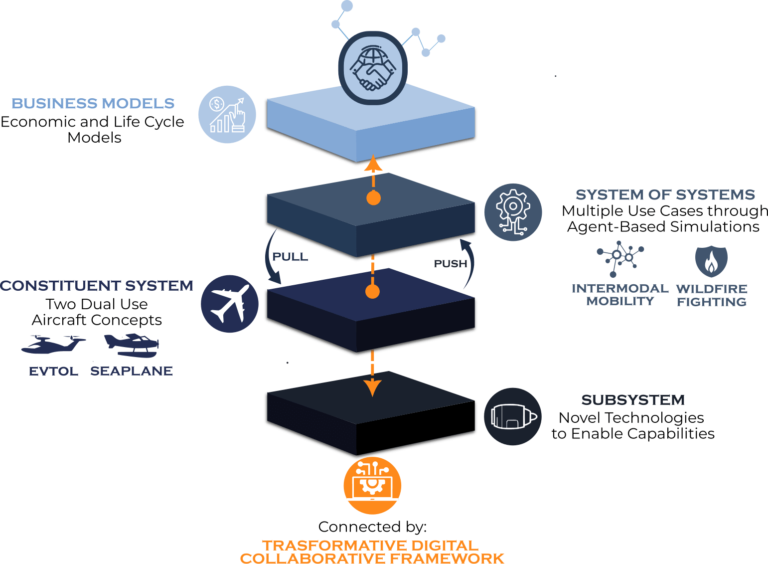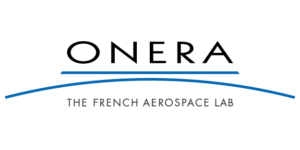THE PROJECT
COLOSSUS PROJECT
System-of-systems are an interoperating collection of component systems, denoted as constituent systems, that produce results which cannot be produced by the individual systems alone. Product design with a holistic system-of-systems approach faces two challenges which go beyond the usual and well-understood practices of systems engineering:
(1) Additional domains have to be investigated and understood to benchmark their impact and capabilities concerning the system-of-systems design space exploration.
(2) Important design parameters are representing non-technical design criteria and are “softer”, or “more fuzzy”, and they possess a higher level of uncertainty.
COLOSSUS will employ a 4-level approach to identify needs, capabilities, and system requirements in the initial phases of the holistic product development process and to cover them appropriately throughout the development circle. The levels are: (I) Sustainability & Business Models (II) System-of-Systems (III) Aircraft as system (IV) subsystem design space.

OBJECTIVE
- To create a Transformative Digital Collaborative (TDC) Framework that allows European aviation to perform research, technology development and innovation in a holistic system-of-systems approach. The TDC Framework shall support modeling, analysis, optimization and evaluation of complex products and services under consideration of real-world conditions.
- To expand and test the capabilities and performance of the TDC framework with two Use Cases, both of which address needs identified in the Work Programme and thus possess a value of their own:
Use Case 1: Creating a business model for sustainable 4D-intermodal mobility and evaluating the concept for performance, competitiveness, environmental impact and life cycle footprint.
Use Case 2: Developing an integrated fast-response approach for preventing, detecting and fighting wildfires by combining latest developments in the fields of aircraft design and technology, automation, AI and digitalisation. - To perform conceptual studies for two products which could be transverse technology enablers for multimodal mobility and affordable decarbonisation of aviation: a multi-role seaplane with hybrid propulsion and a product for eVTOL-based advanced air mobility of passengers and goods.
The overall COLOSSUS structure is organized in 6 Work-Packages (WP) representing the main activities.

WP leader: DLR
WP contributors: DLR, LIU, ONERA, UNINA, SAAB, TECNAM, TUD, FOKKER, Thelsys, INCAS, POLITO, SmartUp, CFSE
WP objectives:
- To manage the project in terms of legal, contractual, ethical, financial and administrative aspects as well as its decision making processes
- To supervise the quality of the project’s deliverables and the reporting processes
- To represent the project externally and in front of the European Commission Scientific management, Administrative & financial management
WP leader: SAAB
WP contributors: DLR, LIU, ONERA, UNINA, SAAB, TECNAM, FOKKER, Thelsys, INCAS, POLITO, SmartUp, VTI
WP objectives:
- Identify stakeholders & stakeholders needs with associated KPI
- Develop relevant scenarios based on the identified needs
- Needs identification & scenarios definition
- Systematic development of business models for all stakeholders in both use cases
- Technology identification and assessment to support both use cases
- Provide cost models and methods to support
- Assessment of development, production, and operating cost (i.e., life cycle cost) at aircraft and SoS level
- Simplified cost / environmental rules to be used for the SoS and aircraft design
- Develop Life Cycle Analysis Models and Provide life cycle assessments
- Perform overall SoS assessment and decision support for all identified stockholders
WP leader: DLR
WP contributors: DLR, LIU, ONERA, UNINA, SAAB, TECNAM, TUD, FOKKER, Thelsys, INCAS, POLITO, SmartUp, VTI, CFSE
WP objectives:
The objective of WP3 is to collect, develop and provide methods and tools that support, improve and accelerate the multi-expert collaborative development of the System-of-Systems (SoS) addressed in the project, namely the Mobility SoS and the wildfire SoS. These methods and tools will support the definition and modelling of SoS stakeholders and needs (application in WP2) and the architecting, modelling, design and optimization of SoS (applications in WP5) and Constituent Systems (applications in WP4). In addition, the methods and tools provided in WP3 will enable the traceability among all elements
WP leader: UNINA
WP contributors: DLR, LIU, ONERA, UNINA, TECNAM, TUD, FOKKER, Thelsys, INCAS, POLITO, SmartUp, VTI, CFSE
WP objectives:
- Include seaplane and UAM digital modelling into the transformative technologies to test the effectiveness of the aircraft product design
- Define the optimal aircraft products with respect to market, aircraft and SoS requirements
- Assess the impact of new technologies (hybrid propulsive powertrain, eVTOL) on aircraft products
- Verify the resilience of the designed aircraft products to diverse scenarios, including innovative solutions. Vice versa: verify the resilience of the SoS layer to different aircraft designs, requirements, and innovative technologies
WP leader: LIU
WP contributors: DLR, LIU, ONERA, UNINA, SAAB, TECNAM, TUD, FOKKER, Thelsys, INCAS, POLITO, VTI
WP objectives:
In WP5, SoS analytical (simulation) workflows and models are being realized. Key enablers for such scenario analyses are the multi-domain use-case specific agent-based modelling (ABM) and simulations, which are being realized and optimized based on the inputs from WP2 (capabilities, performance indexes and live cycle costs), WP3 (MBSE framework, AI and optimisation algorithms) and WP4 (vehicle performances). This includes not only the population and instantiation of the ABM environments and vehicles but also requires top-notch research on efficient high-performance ABM modelling to enable the required vast SoS design space exploration (DSE). The ABM research conducted in this work package focus on efficient ways of ABM implementations, enabling parallel processing (executed on computer cluster/supercomputers), routing, and behavioural (vehicle operation and collaboration) modelling using rule- and AI-based approaches. Finally, the implemented use cases will be optimized and analysed.
WP leader: CFSE
WP contributors: DLR, LIU, ONERA, UNINA, SAAB, TECNAM, TUD, FOKKER, Thelsys, INCAS, POLITO, SmartUp, VTI, CFSE
WP objectives:
The objectives of this WP are to ensure that the results obtained within the COLOSSUS project are widely communicated and disseminated, and to prepare the exploitation plan of the project results. In particular:
- Ensure the communication and dissemination of the project, its results and achievements towards the target groups
- Prepare and implement a strategy for the exploitation of the project results
- Monitor the projects results for possibilities of IPR protection and Innovation potential
- To organise data management within the project (Data Management Plan / Knowledge data management and protection)
Extraordinary Experiences
Click edit button to change this text. Lorem ipsum dolor sit amet, consectetur adipiscing elit. Ut elit tellus, luctus nec ullamcorper mattis, pulvinar dapibus leo.
Our Core Values
- Locavit liberioris possedit
- Diremit mundi mare undae
- Spectent tonitrua mutastis













